Traditional Chinese Painting
Chinese painting represents one of the oldest continuous artistic traditions in the world, which, since its beginnings, has been distinguished by its strong didactic intent, having the purpose of educating to the most noble social values. In fact, the painter, who is also considered a philosopher and a sage, spreads the aforementioned principles through the representation of the four traditional themes, namely landscape, animals, flowers, plants and, on some occasions, even portraits. Despite this plurality of topics, however, Chinese painting, aimed at capturing reality in its most intimate essence, prefers depictions of the natural world. Moreover, this art is also distinguished by being closely linked to calligraphy, which is used to enrich the surfaces of paintings with poems, passages and reflections. This fusion of painting and writing has the task of revealing the mysteries of the depicted reality and the feelings, sensations and ideas of the author. As for the techniques, however, Chinese art, referring to the procedures of calligraphy, uses a brush dipped in black ink or colored pigments, which are placed on various media, among which, the most traditional are silk and paper. It should be noted that Chinese art is characterized by two main painting techniques: the Gongbi, meticulous, precise and detailed, which, often colored, describes figurative or narrative subjects, and the Shaded Ink Painting, in Chinese Shui-mo, freely denominated also as watercolor or hand painting. What has been said concerns the style and techniques of traditional Chinese painting, namely Guóhuà, which is clearly distinguished from the art that was strongly influenced by the West during the 20th century.
Chinese Landscape Painting
Landscape painting, known as Shan shui (mountain and water), deals with the highest, most widespread and appreciated theme of traditional Chinese art, in order to express the artist's feelings, ideas and spiritual conception, rather than a faithful reproduction of nature. This type of investigation aims to remove the viewer, but also the artist himself, from the monotony of everyday reality, stimulating feelings of peace and serenity. Following these intentions, are mainly represented the mountains, high and strong abodes of the gods, and the waters, soft and fluid. In fact, right among the mountain ranges, far from the civilized world, painters are able to communicate with the spirit and nature, realizing the connection between earth, heaven and humanity. Moreover, according to Taoist philosophy, the high peaks of the mountains represent yang, while the flowing streams of water, which cross them, are ying. Precisely the balance between these last two elements is considered by the Chinese to be an essential aspect in the design of a landscape painting. From a historical point of view, Shan shui has permeated Chinese art for over 1500 years, appearing at the end of the Tang era (618-907 AD), and imposing itself forcefully during the Song dynasty (960-1129 AD). Despite the fact that the tenth and eleventh centuries represent the golden age of landscape painting, this will be persisted in the following dynasties Yuan, Ming and Qing, renewing and consolidating itself as the most suitable means to express the qualities of the painter, wise and erudite. As for contemporary art, it too has not abandoned Shan shui, which continues to be investigated, albeit with a new sensitivity. In fact, there is a strong need for the artists of our times to retrace the link with their tradition, which is often expressed through direct quotations of the masterpieces of the past.
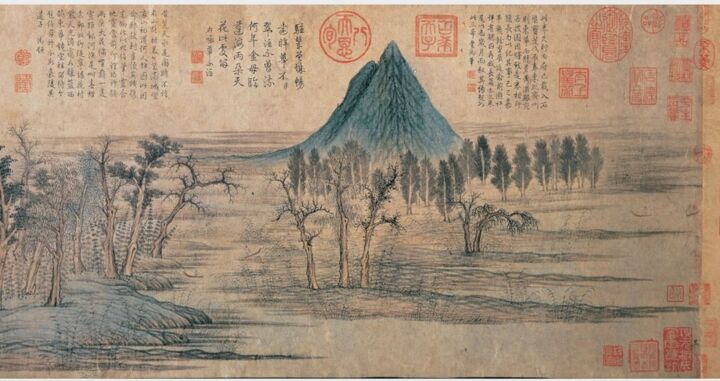 Zhao Mengfu, Autumn colors on the Qiao and Hua mountains (a section of the paper roll), 1295. Ink on paper, 28 x 90 cm. Taipei: National Palace Museum.
Zhao Mengfu, Autumn colors on the Qiao and Hua mountains (a section of the paper roll), 1295. Ink on paper, 28 x 90 cm. Taipei: National Palace Museum.
 Jing Hao, Travelers in a snowy landscape. White pigment and ink on silk (hanging paper roll), 135 x 75 cm. Kansas City: The Nelson-Atkins Museum of Art.
Jing Hao, Travelers in a snowy landscape. White pigment and ink on silk (hanging paper roll), 135 x 75 cm. Kansas City: The Nelson-Atkins Museum of Art.
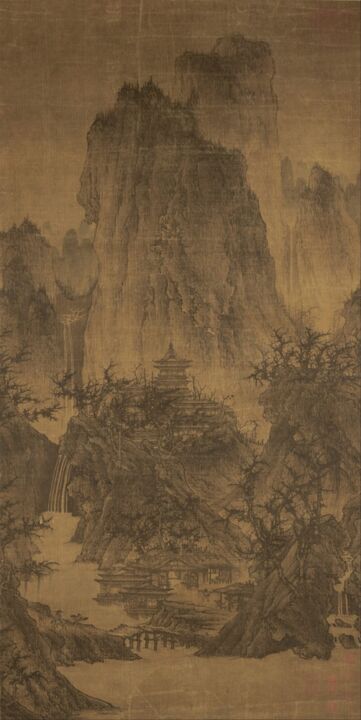 Li Cheng, A solitary temple among limpid peaks. Ink on silk (hanging paper roll), 112 x 55 cm. Kansas City: The Nelson-Atkins Museum of Art.
Li Cheng, A solitary temple among limpid peaks. Ink on silk (hanging paper roll), 112 x 55 cm. Kansas City: The Nelson-Atkins Museum of Art.
 Fan Kuan, Mist Only, 11th century. Ink on silk (hanging paper roll). Tapei: National Palace Museum.
Fan Kuan, Mist Only, 11th century. Ink on silk (hanging paper roll). Tapei: National Palace Museum.
 Wang Ximeng, A Thousand "Li's" of Rivers and Mountains (detail), ca. 1113. Paper roll, 11.9 m (length). Beijing: Beijing Palace Museum.
Wang Ximeng, A Thousand "Li's" of Rivers and Mountains (detail), ca. 1113. Paper roll, 11.9 m (length). Beijing: Beijing Palace Museum.
 Huang Gongwang, Dwelling in the Fuchun Mountains: the scroll of Master Wuyong, 1347-1350. Ink on paper (section of the roll of paper), 33 x 636 cm. Taipei: National Palace Museum.
Huang Gongwang, Dwelling in the Fuchun Mountains: the scroll of Master Wuyong, 1347-1350. Ink on paper (section of the roll of paper), 33 x 636 cm. Taipei: National Palace Museum.
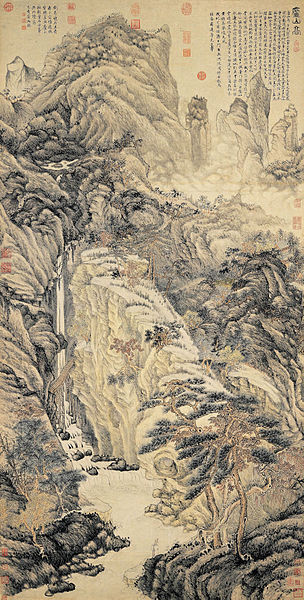 Shen Zhou, Lofty Mount Lu. Ink and color on paper (hanging paper roll), 193.8 x 98.1 cm. Taipei: National Palace Museum.
Shen Zhou, Lofty Mount Lu. Ink and color on paper (hanging paper roll), 193.8 x 98.1 cm. Taipei: National Palace Museum.
 Lianxiang Jiang, Seclusion, 2019: Pigments on paper, 69 x 69 cm.
Lianxiang Jiang, Seclusion, 2019: Pigments on paper, 69 x 69 cm.
Lianxiang Jiang: Seclusion
The painting by Artmajeur's artist, Lianxiang Jiang, shows a classic example of Shan shui, depicting a quiet rocky landscape with trees and houses, which, surrounded by water, was made on the typical paper support. The work, which, as per tradition, transmits a sense of calm and serenity, refers to the great classics of the genre, in fact, the style of realization of the trees and houses recalls that of the master Zhao Mengfu, Chinese painter and calligrapher, who lived during the Yuan dynasty. As for the features of the mountains, they recall the work of great artists who lived between 855 AD and about 1354, such as Jing Hao, Li Cheng, Fan Kuan and Huang Gongwang. Regarding the chromaticism of the artwork, the painting turns out to be akin to the soft hues, but at times also intense, especially with regard to the implementation of darker colors, of Zhao Mengfu's landscapes. Therefore, the balanced composition of the artist of Artmajeur was able to bring back to life the ancient Chinese painting tradition, combining the influences and talent of the greatest masters of all time.
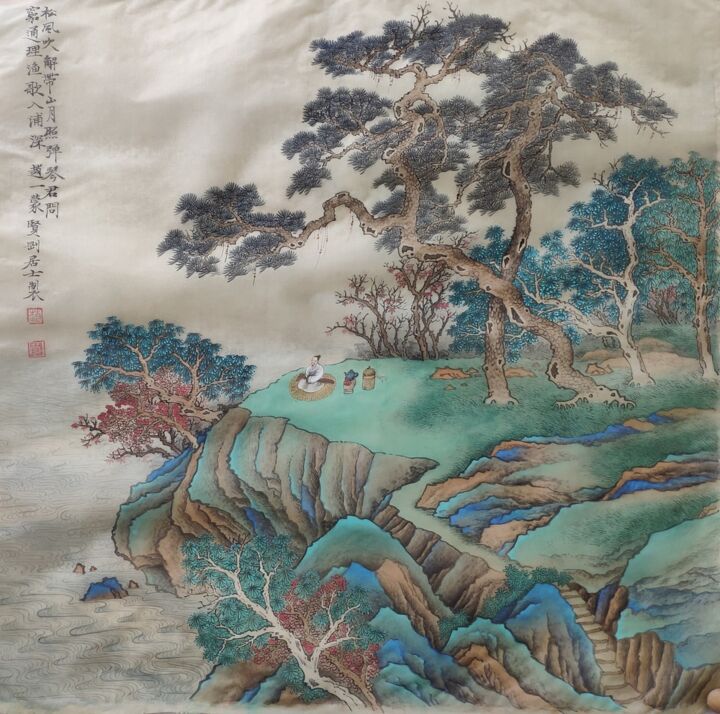 Yimeng Zhao, A genius like a phoenixis hiding in the forest, 2019. Pigments on paper, 44 x 44 cm.
Yimeng Zhao, A genius like a phoenixis hiding in the forest, 2019. Pigments on paper, 44 x 44 cm.
Yimeng Zhao: A genius like a phoenixis hiding in the forest
Artmajeur artist Yimeng Zhao's painting on paper, depicting a rocky coastal landscape, re-proposes the realistic rendering of trees by master Zhao Mengfu, combining it with the triumph of green and blue hues that characterize the work of Wang Ximeng and Zhao Boju. In line with Taoist philosophy, which has clearly influenced the Shan shui masterpieces of the past, A genius like a phoenixis hiding in the forest transmits a strong sense of calm, conferred by the presence of a character who, intent on meditating, makes us move away from the chaos of our daily routine. Finally, again in keeping with tradition, Yimeng Zhao's painting, which is also accompanied by a short calligraphy, has immortalized the aforementioned ascetic by making it on purpose in a small size, in order to highlight man's limitations in the face of the vastness and power of nature. Therefore, the work of the artist of Artmajeur, marked by the elegance of the stylistic elements of tradition, also invites us to introspection and isolation, effective tools for personal growth.
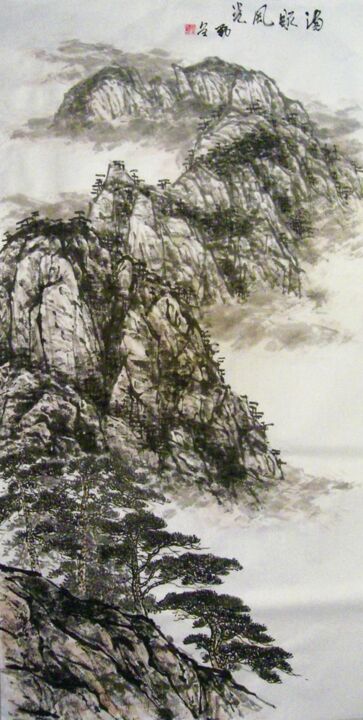 Jinbing Huang, without title, 2018. Inchiostro su carta, 138 x 69 cm.
Jinbing Huang, without title, 2018. Inchiostro su carta, 138 x 69 cm.
Jinbing Huang: without title
The painting on paper by Artmajeur's artist, Jinbing Huang, represents only some mountains in an indefinite context, which, "decorated" by the presence of some trees, are perfectly in line with the stylistic features of traditional Chinese landscape painting, such as those realized by Jing Hao, Li Cheng and Huang Gongwang. The work of these last masters has also largely influenced that of painters of later periods, such as Shen Zhou, an artist active between the 15th and 16th centuries, whose paintings, in particular Lofty Mount Lu, is very reminiscent, in terms of perspective and the way the mountains are made, of the landscape by the artist of Artmajeur. Therefore, the harmony, refinement and calm of Jinbing Huang's traditional Shan shui, leads us into the typical atmosphere of peace, harmony and mere contemplation of nature's beauty, which has distinguished the greatest masterpieces of this genre.

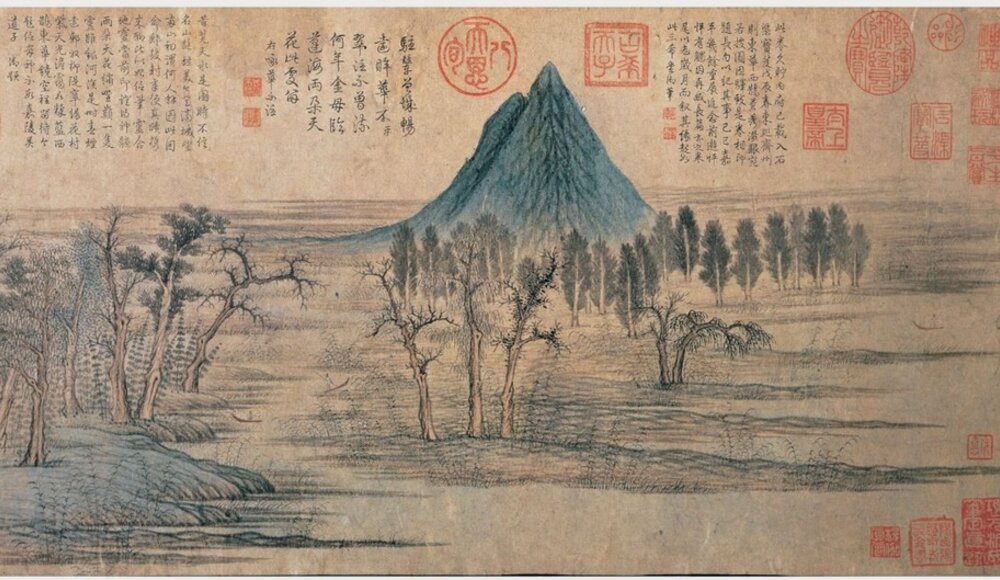
 Olimpia Gaia Martinelli
Olimpia Gaia Martinelli























